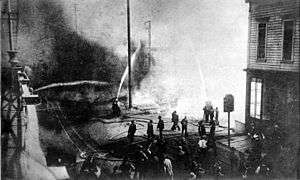Seattle Underground

The Seattle Underground is a network of underground passageways and basements in downtown Pioneer Square, Seattle, Washington, United States that were at ground level when the city was built in the mid-19th century. After the streets were elevated, these spaces fell into disuse, but have become a tourist attraction in recent decades.
History

Seattle's first buildings were wooden. On June 6, 1889, at 2:39 p.m.,[1] a cabinetmaker (Jonathan Edward Back),[2][3] accidentally overturned and ignited a glue pot. An attempt to extinguish it with water spread the burning grease-based glue. The fire chief was out of town, and although the volunteer fire department responded, they made the mistake of trying to use too many hoses at once. With the subsequent drop in water pressure, none of the hoses were effective, and the Great Seattle Fire destroyed 31 blocks.[4]
While a destructive fire was not unusual for the time, instead of rebuilding the city as it was before, city leaders made two strategic decisions: first, that all new buildings must be of stone or brick, as insurance against a similar disaster in the future; and second, that the streets should be regraded one to two stories higher than the original street grade. Pioneer Square had originally been built mostly on filled-in tidelands and, as a consequence, it often flooded. The new street level also assisted in ensuring that gravity-assisted flush toilets that funneled into Elliott Bay did not back up at high tide.
For the regrade, the streets were lined with concrete walls that formed narrow alleyways between the walls and the buildings on both sides of the street, with a wide "alley" where the street was. The naturally steep hillsides were used, and through a series of sluices material was washed into the wide "alleys," raising the streets to the desired new level, generally 12 feet (3.7 m) higher than before, in some places nearly 30 feet (9.1 m).
At first, pedestrians climbed ladders to go between street level and the sidewalks in front of the building entrances. Brick archways were constructed next to the road surface, above the submerged sidewalks. Pavement lights (a form of walk-on skylight with small panes of clear glass which later became amethyst-colored) were installed over the gap from the raised street and the building, creating the area now called the Seattle Underground.

When they reconstructed their buildings, merchants and landlords knew that the ground floor would eventually be underground and the next floor up would be the new ground floor, so there is very little decoration on the doors and windows of the original ground floor, but extensive decoration on the new ground floor.
Once the new sidewalks were complete, building owners moved their businesses to the new ground floor, although merchants carried on business in the lowest floors of buildings that survived the fire, and pedestrians continued to use the underground sidewalks lit by the pavement lights (still seen on some streets) embedded in the grade-level sidewalk above.
In 1907, the city condemned the Underground for fear of bubonic plague, two years before the 1909 World Fair in Seattle (Alaska-Yukon-Pacific Exposition). The basements were left to deteriorate or were used as storage. Some became illegal flophouses for the homeless, gambling halls, speakeasies, and opium dens.
Only a small portion of the Seattle Underground has been restored and made safe and accessible to the public on guided tours. In 1965, local citizen Bill Speidel established "Bill Speidel's Underground Tour," which operates to this day.
Popular culture
The Seattle Underground was featured prominently in the 1973 television movie The Night Strangler (starring Darren McGavin). The film was a sequel to the highly successful 1972 TV movie The Night Stalker and brought a surge in tourism to the Underground afterward. As it turned out, the movie did not actually film in the underground (as the area available was very small). Filming was done in the Bradbury Building and in a Universal Studios soundstage with vaster settings.
The 25th Terry Pratchett novel in the Discworld series, The Truth, mentions that the fictional capital city of Ankh Morpork is built on lower foundations made of Ankh Morpork, and that after significant flooding of the River Ankh, the streets were gradually raised one level, starting with the road, and people used ladders and bridges to cross the street. In the appendix, Pratchett makes reference to the strangeness of reality, as found in Seattle, Washington.
See also
- Catacombs of Rome
- Edinburgh Vaults
- Manchester Cathedral Steps
- Raising of Chicago
- Shanghai tunnels (less commonly known as the Portland Underground, in Portland, Oregon)
- Underground Atlanta
- Underground City (underground features in cities around the world)
References
- ↑ Los Angeles Daily Herald., Seattle in Ashes, June 07, 1889, p.5
- ↑ Hugh McGough, "The Great Seattle Fire—Don't Blame Jimmie McGough"
- ↑ Seattle Post-Intelligencer, The P-I error that changed Seattle history, July 22, 2011
- ↑ Los Angeles Daily Herald., The Seattle Fire, June 08, 1889, p.5.
Further reading
- Speidel, Bill (1978). Doc Maynard, The Man Who Invented Seattle. Nettle Creek. ISBN 0-914890-02-6.
- Speidel, Bill (1990). Sons of the Profits. Nettle Creek. ISBN 0-914890-06-9.
External links
| Wikimedia Commons has media related to Seattle Underground. |